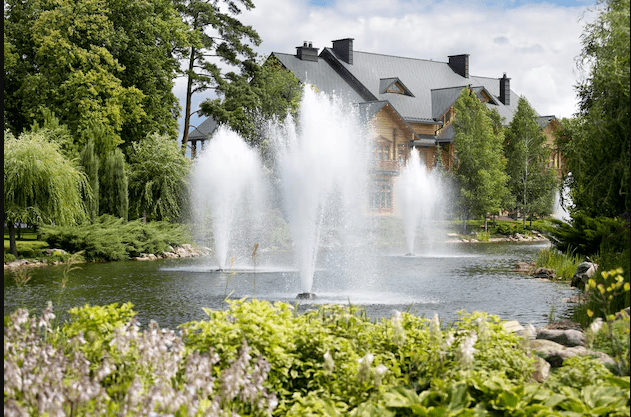Seasonal Tips for Maintaining Pond Fountains Year-Round
The gentle sound of cascading water that once brought peace and tranquility to garden spaces can quickly transform into a source of frustration when pond fountains fail at the worst possible moments. What begins as a symbol of serenity becomes a costly reminder of neglect when pumps seize in winter cold or algae blooms turn crystal-clear water into murky green soup during summer heat waves.
Photo : Freepik
David installed his dream pond fountain in spring, mesmerized by the dancing water patterns and the way evening light played across the gentle ripples. By the first hard freeze, his beautiful water feature had become an expensive ice sculpture with a cracked pump housing, and the following summer brought clouds of mosquitoes and thick algae that turned his peaceful retreat into an eyesore. Everything changed when he learned that fountain maintenance follows nature’s calendar, with each season demanding specific care rituals that prevent problems before they start and preserve the magic of flowing water through every weather extreme.
The secret to year-round fountain success lies not in expensive equipment or complicated systems but in understanding how seasonal changes affect water features and preparing accordingly. When maintenance routines align with natural cycles, fountains become reliable sources of beauty and tranquility that enhance outdoor spaces regardless of weather conditions. This seasonal approach transforms fountain care from reactive crisis management into proactive stewardship that protects both investment and enjoyment throughout every season.
Spring: The Restart Phase
Spring is when you start noticing what winter may have done. Ice damage. Cracked tubing. Some scum inside the pump housing.
It’s worth taking everything apart, even if nothing seems broken.
- Unplug the fountain before handling anything.
- Lift the pump and rinse off any visible residue.
- Rotate the impeller a few times. If it sticks or feels uneven, you’re better off swapping it.
- Scrape out stubborn grime from around the openings.
Don’t assume the flow will look the same as it did last year. Settings might need adjustment. And if your fountain isn’t clearing the same distance or height, that could mean the gallons per hour performance has dropped, maybe from build-up inside or a slipping impeller shaft.
If anything feels too tight or dry, consider re-lubricating where applicable, especially for pumps that sat unused through winter.
Summer: Keep It Cool, Literally
Heat brings out the worst in neglected water features. Water evaporates faster. Leaves dry and crumble into dust that floats straight into your fountain’s intake. Birds crowd the edges. Pets sometimes drink from it, disturbing the water.
Small things, but they add up.
- Monitor the water level every few days.
- Don’t let the pump gulp air, it can overheat without warning.
- If the spray shape changes, it might be a sign of pressure imbalance.
You might be tempted to toss in an algaecide when the water starts turning green, but chemicals aren’t always compatible with pump parts. Instead, shade helps. Try adding lily pads, marginal plants, or even a floating ring if the sun hits too strong for too long.
Also, that foamy buildup? It usually forms when organic matter breaks down in the water. Clean filters regularly, and maybe space out feedings if you keep fish.
Autumn: Trouble from Above
Leaves. Always leaves. They’re the season’s biggest problem for outdoor fountains. One weekend without checking and you could find the intake choked, forcing the motor to work too hard.
Some skip autumn maintenance, thinking they’ll shut the system off soon anyway. That’s a mistake.
- Set up a leaf net to trap debris before it hits the pond surface.
- Rinse out the filter more frequently.
- Shorten the spray height if winds start picking up.
Cooler temperatures also change how bacteria form in the water. What looked clean in summer might go murky in a few days. That’s normal, but it still needs monitoring.
If you’re using a submersible pump, test whether it’s still seated properly. Vibrations from seasonal run time can shift its position slightly, causing weird noises or spray direction changes.
Winter: Risk or Hibernate?
People debate whether to run pond fountains through winter or store them away.
Running them keeps a hole in the ice, allows for oxygen flow, and helps wildlife. But it’s not always safe.
If freezing is likely:
- Remove the pump entirely.
- Empty the water from all the tubing.
- Keep the components dry and indoors.
If mild winters are typical in your region:
- Keep the unit submerged but at a deeper point in the pond.
- Reduce the flow rate.
- Break off ice from the spray head if it starts forming, carefully.
Ice can wrap around wires, nozzles, or even fountain heads and expand slowly until something cracks. Some don’t see the damage until months later.
And there’s always the chance of an unexpected cold snap, which is why more cautious pond owners switch to aerators in winter.
Small Notes That Matter
- Power cords become brittle in cold months. Store them flat and untangled.
- Don’t wait for a full blockage before cleaning. Water pressure loss is the first clue.
- Keep spares nearby like a second impeller, o-ring, or hose clamp. Those tiny delays waiting for a part can stretch a repair job longer than needed.
Honestly, there’s no set rulebook. What matters is watching and adjusting. The spray might look right, but still be off by a few degrees or gallons. You can hear the difference, sometimes even feel it in the mist if you stand nearby.
Mastering the Rhythm of Water Through Time
The transformation from struggling with fountain failures to enjoying consistent water feature performance requires embracing the natural rhythm that governs all outdoor water systems. Each season brings specific challenges and opportunities, from spring startups that require careful pump inspections to winter preparations that protect expensive equipment from freeze damage. This cyclical approach to maintenance creates a sustainable routine that prevents costly repairs while ensuring the soothing sounds of flowing water remain constant companions throughout the year.
The investment in seasonal fountain care pays dividends far beyond avoided repair bills, creating outdoor spaces that maintain their tranquil atmosphere regardless of weather extremes or temperature fluctuations. Neighbors notice the difference when fountains run smoothly through harsh winters and algae-free summers, while homeowners enjoy the daily pleasure of reliable water features that enhance property value and personal satisfaction. The consistency of well-maintained fountains creates anchor points of serenity that ground outdoor spaces in natural beauty.
Your fountain’s potential for year-round performance awaits the simple commitment to seasonal care that honors both mechanical needs and natural cycles. The peaceful water sounds that drew you to fountain ownership can become permanent fixtures in your outdoor sanctuary with the right maintenance approach for each season. The magic lies not in avoiding all problems but in preventing the major ones while embracing the natural rhythm that keeps water flowing beautifully through every season.






